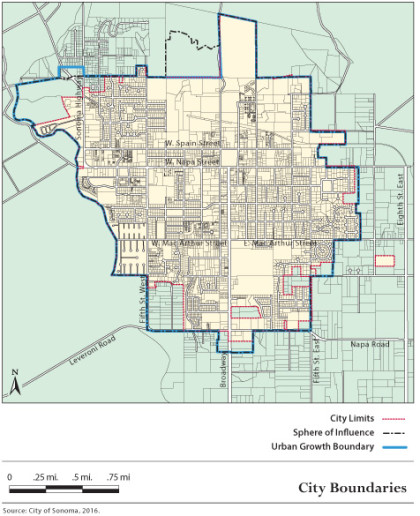Sonoma’s Urban Growth Boundary (UGB) is performing exactly the way it was intended. Agricultural land and open space beyond the city’s borders have been preserved, but preventing sprawl was always the simplest and most obvious intent. The less obvious intent now manifesting is creatively-designed, higher-density infill housing projects.
It has taken eighteen years for the UGB to generate this latter effect; the community is now taking notice but it’s also created misperceptions. The pace of infill has been slow for large, vacant parcels zoned for housing to be developed, such as those on West Spain Street. This slow pace attests to the realities of land-use patterns in Sonoma: the ups-and-downs of the housing market, and the availability of plenty of parcels for development. Given Sonoma’s Growth Management Ordinance limiting development to an average of 65 units per year and the availability of parcels, the pressure to develop has been modest.
The UGB was designed to create a condition of parcel “scarcity” that prompts infill development at higher density to satisfy housing demand. “Scarcity” means that remaining undeveloped parcels are therefore more carefully and creatively designed. The older, 20th century development pattern of detached, single family homes with large, park-like yards on 6,000 sq. ft. lots based upon abundant land is yielding to smart, 21st century needs for diverse housing stock–multi-family, apartments, and government-regulated affordable housing–based on limited land availability. After 18 years, it’s finally happening.
Parcels with older, often run-down single family homes are being re-developed with multi-family units; the completed Ledson project on West Spain is an example. Seven or eight older structures were removed and eighteen new housing units, all rentals, were created. The same is contemplated for a parcel behind the El Pueblo Motel. Going forward, infill will proceed in this manner, combined with the re-development of commercially-zoned parcels large enough to include required housing. Protecting agricultural land and open space always required the trade-off of higher-density infill development within the urban boundary.
One element in the land-use formula that needs immediate attention is generating revenues for government regulated affordable housing. It was not anticipated that Redevelopment Agency funding would disappear after 2011, and the City of Sonoma has been too slow to respond with new revenue sources to fund its affordable housing program. In fact, it has no funding and no program, even after seven years, and substantial revenue opportunities have been lost. If the city now gets serious and adopts new fees, taxes and financial instruments to raise substantial funding, some of that lost ground can be recovered.
Some complain the UGB has raised land prices; as regional population grows, land prices throughout the Bay Area have increased, even in unincorporated areas without any UGB. In popular and attractive towns like Sonoma, this is particularly true. That’s the nature of capitalism.
Renewal of the UGB in its existing form will insure that it can continue to function as intended in its maturity. Between the remaining undeveloped parcels (which are substantial if not immediately obvious), already developed parcels which are good candidates for reuse and re-development, and commercial parcels large enough to add substantial housing, the protection of Sonoma’s greenbelt can continue. An expansion of the UGB will subvert its intention by relieving pressure on land-use and returning Sonoma to inefficient and wasteful housing development.
